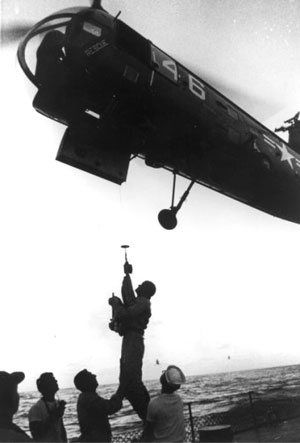John Glenn and the Flying Bananaby Dwayne A. Day
|
| Glenn probably would not have gotten that ride on the “Flying Banana” except for a mistake. |
The helicopter was a Piasecki HUP-2. “H” for “helicopter”, “U” for “utility,” and “P” for “Piasecki.” The HUP-2 was a later version of the XHRP-X, which had earned the nickname “the Flying Banana.” Like the development of the airplane, the helicopter faced two primary challenges: control and power. Early pioneers, particularly Igor Sikorsky, had tackled the control problem. But that still left the power problem—for several decades helicopters lacked the power to lift more than about three people off the ground. In addition, that big whirling rotor overhead caused the fuselage to rotate in the opposite direction. To counteract this, a helicopter needs a small rotor at the tail, mounted vertically, to push the tail in the opposite direction. This is very inefficient for lots of reasons, including the fact that it requires power.
As a teenager in the 1930s, Piasecki worked for a Philadelphia company that made autogyros. He studied mechanical engineering at the University of Pennsylvania and in 1940 created the PV Engineering Forum, deliberately avoiding using the name “helicopter” because he wanted people to take him seriously. (The “V” stood for Harold Venzie, his business partner. You can figure out what the “P” stood for.) In the early 1940s he built a single-seat helicopter with a single three-blade rotor and designated it the PV-2. He towed it behind his Studebaker to Washington, stopping every 10-15 minutes to splash water on the overheating helicopter wheels, which had no bearings. He successfully demonstrated the helicopter to the War Department and got a contract.
After the war there was little military funding for helicopter development and their power limitations restricted their usefulness. Piasecki came up with a simple solution for increasing power—he added a rotor. Without a tail rotor, all of the engine power went into providing lift. There had been other helicopters with two rotors, but they mounted them side-by-side. Piasecki put one in front and the other in back, with a long thin airframe between them. The rear rotor was mounted higher, on a slender sloping fuselage, hence the nickname Flying Banana.
The solution may have seemed simple, but the devil was in the details. The control system was more complex, because yawing the helicopter to the left or the right was no longer as simple as merely adjusting a tail rotor. Rival Sikorsky also claimed that the two rotors would create wash that would interfere with each other. But Piasecki quickly solved these problems.
Not only could Piasecki’s helicopter lift more, but that long fuselage had another advantage because the cargo it carried, including people, could be moved around and did not have much effect upon the aircraft’s center of gravity. For single rotor helicopters, it was important that the cargo and passengers not be located too far from underneath the center of the rotor, otherwise the helicopter design has to compensate in some manner, such as adding ballast. The result was that Piasecki’s design could carry more people and move them around the cabin, which made it ideal for tasks such as ocean search and rescue—a helicopter might go to sea with a crew of three, and pick up several survivors of a plane crash or a sinking ship. The Coast Guard was an early Piasecki customer.
Of course, Igor Sikorsky did not simply give up. In order to minimize center of gravity changes for cargo and passenger loading and unloading, he radically changed the configuration of his helicopters. He put the cabin directly under the rotor, moved the engine to the nose, and put the pilots above the cabin. This solved many problems—it allowed unrestricted cargo loading, improved access to the engine, and raised the tail and main rotors for safety. The resulting helicopter was designated the S-55, and it was quite popular. Sikorsky followed it with a similar version known as the S-58, or the H-34 in military service. Look at a picture of a soggy Gus Grissom being lifted into a helicopter. That’s an H-34. The same type plucked Al Shepard out of the water as well.
| Piasecki’s legacy endures, even if he does not. |
Neither the H-34 nor the HUP-2 is as iconic as the famed Sikorsky Sea King that started recovering Gemini and Apollo astronauts later in the 1960s. The Sea King, especially the one marked with the designation “66,” appeared in countless photographs and film footage of astronaut recoveries (see “Helo 66 revisited”, The Space Review, July 9, 2007). The Sea King benefited from the development of compact jet turbines that found their way into helicopters starting in the late 1950s (most notably in the famed Bell “Huey”). The jet turbines provided all the power that these helicopters needed, and their earlier brothers like the S-55 and HUP-2 with their conventional engines simply could not compete. But today several HUP-2s are on display in museums, some painted to resemble the helicopter that recovered Glenn from the deck of the Noa. One is aboard the USS Hornet Museum in Alameda, California. Another is at the nifty little Air Zoo Museum in Kalamazoo, Michigan.
Piasecki later sold his company and it is now part of Boeing—as is virtually every other early aircraft manufacturer. Boeing still produces the big dual rotor Chinook, one of the most powerful helicopters currently flying. But the dual rotor design never really caught on with other manufacturers, in part because it is really only necessary for certain tasks such as heavy lift. The design’s great resistance to changes in center of gravity is one of the reasons why the U.S. Army uses it—they load it up with 40+ paratroopers who then all run out the back while in flight, and the helicopter keeps flying straight and level. Piasecki’s legacy endures, even if he does not.
